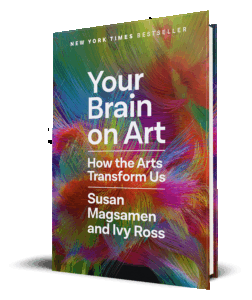SDA Book Club: Your Brain on Art reviewed by Vivien Zepf
April 4, 2025
Your Brain on Art: How the Arts Transform Us by Susan Magsamen and Ivy Ross

As I type the word “neuroarts” into my computer, auto-correct underlines the word, suggesting that I’ve made an error. I haven’t. My computer has. Neuroarts is a relatively recently coined term and a broad label describing the burgeoning scientific field investigating how the arts and aesthetics affect us. As Ruth Katz(1) is quoted as saying, “Achieving well-being is both an art and a science, and neuroarts bridges that gap”. What does that mean?
Each of us is unique in so far as our life experiences vary greatly and our health is affected by our environment and genetics. That said, our brains function similarly. Because of that commonality, scientists are mapping how our brains respond to different experiences and tracking what parts of the brain are activated by stimuli. Furthermore, scientists are asking, What neural activities are connected to our overall health? Neuroarts explores the quantifiable physiological impact of engaging in a creative activity such as dance or theater, painting or poetry. In their book Your Brain on Art, authors Susan Magsamen and Ivy Ross help us understand the overwhelmingly positive influence the arts have on our humanity and biology.
Before diving into the meat of the matter, the authors first ask readers to consider if they have an aesthetic mindset, defined as an openness and awareness of your environment, the arts and your response(s) to it . They offer a short questionnaire for readers to gauge how regularly they might seek out experiences to enrich their creative lives. Readers are also given a brief lesson in brain functionality and, once readers have a firm(er) grasp on mechanics and concepts, the authors begin to unfold the evidence that reveals how critical it is, as individuals and as communities, to find time to allow for creative experiences.
Magsamen and Ross spent years conducting their own research, as well as interviewing and meeting with creative practitioners and scientists, to synthesize the myriad ways art improves our well-being. The authors discuss how we all biologically benefit from personal creative making and enjoyment, whether that’s knitting or viewing an exhibition. They also delve into broader and far-reaching topics. They note that children deprived of the arts during their formative years show decreased executive function, which translates into a lesser capacity to engage cooperatively or manage conflict with others. Health practitioners are beginning to recognize how art can trigger hundreds of biological mechanisms which can be productively harnessed to heal an illness or relieve chronic issues. For example, an immersive virtual reality program called Snow World helps burn victims manage their pain during wound care. Trauma victims can benefit from art or sound therapy, each one offering different physiological and psychological relief. Nature provides endless opportunities to experience wonder and awe, states of being that feed relaxation, bliss and curiosity. As a result, there is increasing attention being paid in care and research facilities to bring nature into their spaces to cultivate that mindset. These are just a few of the fascinating and impactful ways we are nurtured by the arts.
Neuroarts is providing us with scientific evidence clarifying how a sensory-rich environment, filled with exploration, creativity and play, improves our state of being. Your Brain on Art, which is a very readable and important book I believe, shares an impressive multi-dimensional collection of examples. And, having read the book, I am more convinced than ever that my personal art practice is vital, even when it is solely for my own enjoyment.
(1) Ruth Katz is a vice president at the Aspen Institute, as well as the executive director of its Health, Medicine & Society Program. She also co-directed the release of Neuroart Blueprint with author Susan Magsamen.
–Viven Zepf
- Publisher: Random House (buy it here)
- Date: March 2023
- ISBN: 978-0593449233
If you’ve read this book, leave a comment and let us know what you think!
Do you have a recommendation for a recent fiber-related book you think should be included in SDA’s Book Club? Email SDA’s Managing Editor, Lauren Sinner, to let her know!

1 Comment
Brittany says
April 4, 2025 at 11:30 pm
We read this book for our Artists + Creatives Book Club, and had a vigorous discussion! So many activities that we naturally enjoy to do as children (singing, dancing, playing, drawing, etc) are shown in the book to be great for our brains and well being, yet we become self conscious, and mostly grow out of these past times. The book offers an invitation to return to these joyous activities to help us heal, grow and flourish through our lives.